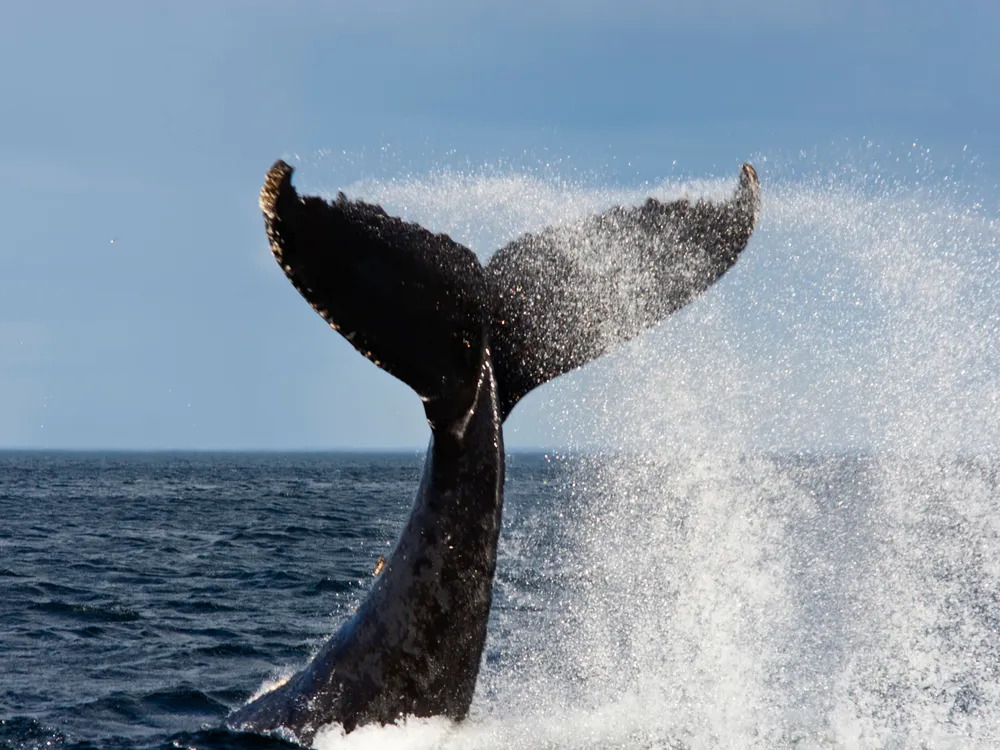Whales
Whales can't swim backward.
How would you describe the shape of a whale or dolphin? Wouldn't you say they are very streamlined? Very few appendages (like your arms and legs) stick out to slow the animal down as it swims through the water. A whale's body is shaped like a submarine or the body of an airplane.
The smooth, rubbery skin, the lack of hair, and no ears sticking out also contribute to the sleek body designed for speed in the water.
But it takes more than a sleek body to maneuver in the water. Remember, when whales and dolphins go after their food, they swim at the surface and dive to great depths. They need rudders and propellers.
Look closely at a whale or dolphin. You'll see that many have a dorsal fin, the fin that sticks up from the back of the animal. Scientists believe that the dorsal fin acts as a stabilizer or a rudder. You might think the dorsal fin has bones, like the fins on fish. But the whale's dorsal fin has no bones. Instead, it is composed of dense tissue, somewhat like a thick, folded skin ridge.
You'll also see flippers low on the sides of the animals. Those flippers are used for steering, balancing, and for stopping. But they are not used for moving forward through the water.
Forward motion is created by the whale's or dolphin's tail, or flukes, moving up and down in the water. It serves as the propeller. Powerful muscles running along the backbone and sides of the whale's body move the tail up and down in the water, providing the power that pushes the animal through the water or deep into the ocean. One way to remember that whales are not fish is that fish move their bodies sideways when they swim; whales move their bodies up and down.
Source: Ultimate Facts
@https://www.smithsonianmag.com/science-nature/todays-whales-are-so-huge-why-arent-they-huger-180969466/
Whales can't swim backward.
How would you describe the shape of a whale or dolphin? Wouldn't you say they are very streamlined? Very few appendages (like your arms and legs) stick out to slow the animal down as it swims through the water. A whale's body is shaped like a submarine or the body of an airplane.
The smooth, rubbery skin, the lack of hair, and no ears sticking out also contribute to the sleek body designed for speed in the water.
But it takes more than a sleek body to maneuver in the water. Remember, when whales and dolphins go after their food, they swim at the surface and dive to great depths. They need rudders and propellers.
Look closely at a whale or dolphin. You'll see that many have a dorsal fin, the fin that sticks up from the back of the animal. Scientists believe that the dorsal fin acts as a stabilizer or a rudder. You might think the dorsal fin has bones, like the fins on fish. But the whale's dorsal fin has no bones. Instead, it is composed of dense tissue, somewhat like a thick, folded skin ridge.
You'll also see flippers low on the sides of the animals. Those flippers are used for steering, balancing, and for stopping. But they are not used for moving forward through the water.
Forward motion is created by the whale's or dolphin's tail, or flukes, moving up and down in the water. It serves as the propeller. Powerful muscles running along the backbone and sides of the whale's body move the tail up and down in the water, providing the power that pushes the animal through the water or deep into the ocean. One way to remember that whales are not fish is that fish move their bodies sideways when they swim; whales move their bodies up and down.
Source: Ultimate Facts
@https://www.smithsonianmag.com/science-nature/todays-whales-are-so-huge-why-arent-they-huger-180969466/
0 Comentários
1 Compartilhamentos
195 Visualizações
0 Anterior



